The AMD Ryzen 5 1600X vs Core i5 Review: Twelve Threads vs Four at $250
by Ian Cutress on April 11, 2017 9:00 AM ESTBenchmarking Performance: CPU Office Tests
The office programs we use for benchmarking aren't specific programs per-se, but industry standard tests that hold weight with professionals. The goal of these tests is to use an array of software and techniques that a typical office user might encounter, such as video conferencing, document editing, architectural modelling, and so on and so forth. At present we have two such tools to use.
PCMark8
Despite originally coming out in 2008/2009, Futuremark has maintained PCMark8 to remain relevant in 2017. On the scale of complicated tasks, PCMark focuses more on the low-to-mid range of professional workloads, making it a good indicator for what people consider 'office' work. We run the benchmark from the commandline in 'conventional' mode, meaning C++ over OpenCL, to remove the graphics card from the equation and focus purely on the CPU. PCMark8 offers Home, Work and Creative workloads, with some software tests shared and others unique to each benchmark set.
Chromium Compile (v56)
Our new compilation test uses Windows 10 Pro, VS Community 2015.3 with the Win10 SDK to combile a nightly build of Chromium. We've fixed the test for a build in late March 2017, and we run a fresh full compile in our test. Compilation is the typical example given of a variable threaded workload - some of the compile and linking is linear, whereas other parts are multithreaded.
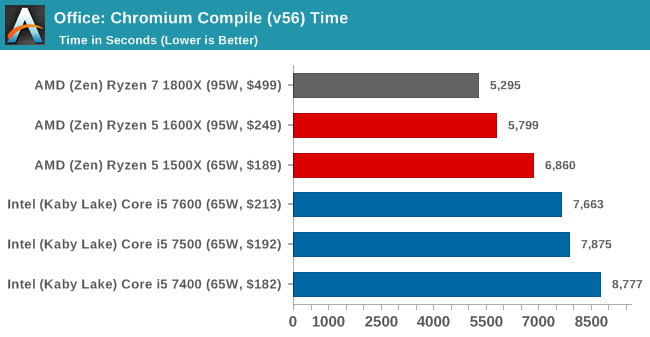
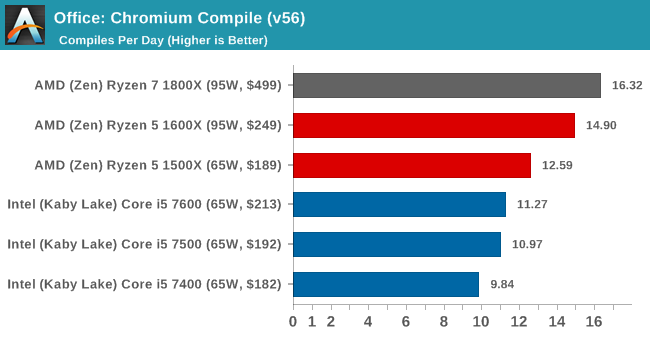
SYSmark 2014 SE
SYSmark is developed by Bapco, a consortium of industry CPU companies. The goal of SYSmark is to take stripped down versions of popular software, such as Photoshop and Onenote, and measure how long it takes to process certain tasks within that software. The end result is a score for each of the three segments (Office, Media, Data) as well as an overall score. Here a reference system (Core i3-6100, 4GB DDR3, 256GB SSD, Integrated HD 530 graphics) is used to provide a baseline score of 1000 in each test.
A note on contect for these numbers. AMD left Bapco in the last two years, due to differences of opinion on how the benchmarking suites were chosen and AMD believed the tests are angled towards Intel processors and had optimizations to show bigger differences than what AMD felt was present. The following benchmarks are provided as data, but the conflict of opinion between the two companies on the validity of the benchmark is provided as context for the following numbers.







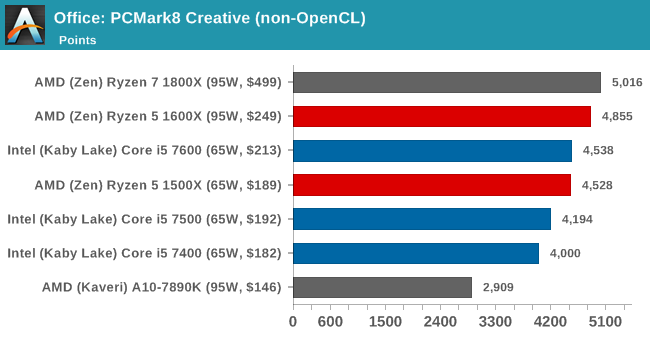
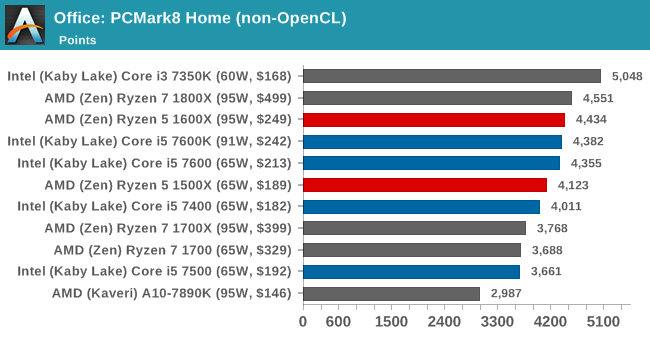
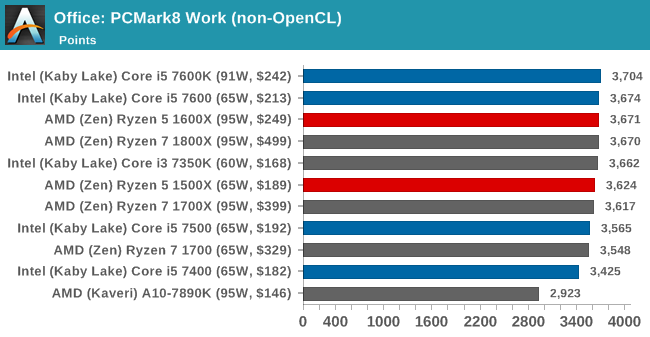








254 Comments
View All Comments
lefty2 - Tuesday, April 11, 2017 - link
Yeah, also with the RX 480 the i5 7400 scores better then i5 7600 (by a huge margin)! That makes no sensesharrken - Wednesday, April 12, 2017 - link
AdoredTV did a very interesting video about exactly this issue, called "Ryzen of the Tomb Raider". In pretty extensive testing they show that something is definitely wrong with Nvidia cards in DX12 on Tomb Raider.https://www.youtube.com/watch?v=0tfTZjugDeg
On a Ryzen 1800X system, crossfire RX 480's beat out an overclocked Titan X, 90fps on the 480's and only 80fps on a Titan X - which is just ridiculously wrong when you look at the relative GPU power.
Some other people have run more tests, and a similar thing is happening in The Division, so it seems highly likely that Nvidia has some strange issues somewhere along the line with DX12.
https://www.reddit.com/r/Amd/comments/62n813/inspi...
milli - Wednesday, April 12, 2017 - link
It's also happening in Battlefield 1, Deus Ex: MD & Total War: W.https://www.computerbase.de/2017-03/amd-ryzen-1800...
Are nVidia drivers not detecting Ryzen CPU's correctly or is it foul play?
mdw9604 - Thursday, April 13, 2017 - link
Poor AVX implementation /w AMD and the driver.milli - Thursday, April 13, 2017 - link
What has AVX to do with nVidia's DX12 drivers???bug77 - Tuesday, April 11, 2017 - link
Really great job not throwing intel power consumption in there for comparison. /sIan Cutress - Tuesday, April 11, 2017 - link
Mainly because that part of the discussion was purely to do with CCX arrangement and core loading.But sure, because you asked so nicely. /s They've been added.
bug77 - Tuesday, April 11, 2017 - link
Thanks.Phiro69 - Tuesday, April 11, 2017 - link
Could you comment on your Chromium Compile benchmark a bit; I'd like to use it as part of a pitch on why our compile farm needs replacing (e.g. "look what a $249 cpu can do").What OS did you build under, I'm guessing Windows 10 from your earlier statements in the full article?
Did you follow these directions for the most part? https://chromium.googlesource.com/chromium/src/+/m...
If so (and you used Windows 10), then you used Visual Studio? Which version and which license of VS?
Thanks! Great review!
Ian Cutress - Tuesday, April 11, 2017 - link
Win 10 x64 Pro v1607, Build 14393.953. VS Community 2015.3 with Win10 SDK. I bascially followed the instructions in that link. :)